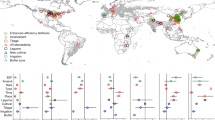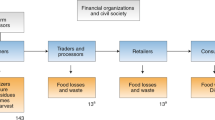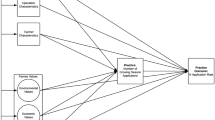Abstract
Farmers may choose to apply nitrogen fertilizer at a rate that exceeds the average ex post agronomically optimal rate when the yield response to nitrogen varies across growing seasons. Negative environmental consequences such as nitrous oxide (N2O) emissions and/or water pollution can result when all the applied nitrogen is not needed by the crop. Here we consider a nonlinear market instrument targeting farmers’ nitrogen use, and by solving for the optimal nitrogen reduction using a model of expected utility of farm profits, we evaluate the induced N2O emission reductions that are consistent with the instrument introduced. The market instrument is nonlinear because of the expected nonlinear relationship between N2O and nitrogen application rates. Our simulations show that, in cases where farmers apply N at rates which exceed recommendations and the N2O response is likely to be non-linear, payments will induce participation in the program and will have a significant impact on both expected and actual N2O emissions without significantly harming expected or actual yields. Failure to consider this nonlinearity would deviate the attention away from N2O pollution because it would require large N reductions (and crop yields) to achieve equivalent N2O abatement.

Similar content being viewed by others
Notes
The value of 298 is the direct GWP for one molecule of N2O on a mass basis for a 100-year time horizon, relative to one molecule of CO2, which is ascribed a value of 1 by convention.
While the majority of the previous and recent evidence points towards a nonlinear curve, there is also evidence that for irrigated corn in Colorado N2O response is highly linear up to 230 kg N/ha (Halvorson et al. 2009, 2014), and that N2O emission factors decrease as N rate increases (Pelster et al. 2011). Kim et al. (2013) in a meta-analysis of 26 published datasets found exponential or hyperbolic responses in 18 datasets, linear in 4, and no response in the rest. Furthermore, Shcherbak et al. (2014) on a global meta-analysis comprising datasets of 78 published studies performed for various crops, soil types, and countries found that the response tends to deviate little from linearity at rates below about 200 kg N/ha.
Conditioning on θ implies that optimal N rate, the solution to problem (1), is different if θ changes, making the problem potentially firm-specific. Therefore, the model is general enough and contemplates as a special case the situation observed in practice where implementation of these type of schemes rely on protocols using a regional N2O-N response curve (Millar et al. 2012, 2013; and CAR 2013).
Other inputs apart from N are not included in the profit function as they remain constant in the optimization problem. While some substitution between inputs is likely to occur in practice, the objective of this analysis is to focus on N optimal application decision.
In the next section we remove the linearity and independence assumptions and solve the expected utility problem under risk aversion and correlated random deviates of yield and prices.
Indirect emissions consist of indirect N2O emissions produced from atmospheric deposition of N volatilized, as well as N2O emissions produced from leaching and runoff of N, both as a result of N applications at the project site.
Offset payments computed based on ϕ underestimate price signals to farmers because the damage function and payment structure do not include abatement of other externalities caused by N application reductions such as the contribution to water pollution of runoff and leached N as well as other indirect effects on human health.
Sensitivity analysis on parameter θ is cumbersome because it requires knowing each curve’s direction of change. Many situations may occur, but for example, N applications (and N2O emissions) will decrease if ϕ′(N; θ) curve shifts up and the marginal value product curve shifts down.
In the previous section, for exposition, we assumed a farmer who maximizes under a linear utility. In what follows, we assume a utility that can accommodate different degrees of risk aversion. However results are very similar for different risk aversion levels.
Conditioning parameters of f(y|N; θ) and ϕ(N; θ) are omitted in the rest of the paper to save notation.
Similarly, to save notation we omit the conditioning parameter θ in ϕ(N; θ).
The Climate Action Reserve (CAR) is currently evaluating its adoption.
This curve is representative of the North-Central region of the United States, which includes the State of Iowa. Therefore, the value of θ in e(N, θ), omitted to ease notation, is set at the average over the firms’ values in the mentioned region.
The Intergovernmental Panel on Climate Change (IPCC) assumes that N2O emissions are a constant proportion of 1.00 +/− 1 % of N applications (IPCC 2006).
The rationale of this assumption is that if we average a farmer’s emission reductions over several years, they will be consistent with the incentive payment received in each year.
Conclusions are conditional on the representativeness of this dataset of Iowa agronomic and weather conditions.
Nitrogen application rates were not updated because average Iowa N rates remained relatively the same in the period (only 6 % increase) and do not have a clear pattern of behavior, as compared to the 51 % increase of yields around a linear trend.
We selected two levels of correlation; one negative based on historical observed correlation between corn yields and prices, and one positive for sensitivity analysis purposes. Negative correlation would exist because when corn prices increase, farmers have the incentive to plant more corn, substituting land away from other uses. If that new corn land is of lower productivity, we can expect a yield decrease. However, positive correlation might occur if higher prices induce changes in management practices with the objective of obtaining higher yields (using high-yielding seeds, higher seed density, different type of fertilizers and/or herbicides).
The risk premium (RP) is the dollar amount an individual is willing to pay to avoid a risky bet and receive a certain profit. For our utility function, the risk premium is found to be \( RP=E\left(\tilde{\pi}\right)+\frac{1}{ra} \log \left[E\left({e}^{-ra\tilde{\pi}}\right.\Big)\right.\Big] \).
Throughout the estimation we assumed a nitrogen price of $722/ton N, equivalent to $0.44/lb N suggested by Iowa State University Extension Services for continuous corn (Duffy 2014). A higher price of N fertilizer relative to corn price induces the participating farmer to optimally make larger N application reductions because the savings from the N not applied are relatively bigger.
Emissions trading systems with various degrees of development, linkages between them, and a wide range of carbon prices are active in EU, Switzerland, United States (California and the Regional Greenhouse Gas Initiative involving nine Northeast and Mid-Atlantic states), Canada (Alberta and Québec), Kazakhstan, Australia, New Zealand, Japan, and pilots in six regions of China. As of March 2014 this range goes from 4.0 to 12.4 $/ton of CO2 and as high as 168 $/ton of CO2 if carbon taxes are considered (World Bank 2014).
Iowa State University Extension Services using the MRTN-based Corn Nitrogen Rate Calculator recommends, for Iowa and for corn and N prices used in this analysis, N application rates between 202 and 231 kg/ha (ISU Extension 2014).
The standard error of the emissions curve is: σ e(N) = 0.058 × exp[0.01 × N] (Millar et al. 2010).
We solved the model with a positive correlation (ρ = 0.30), and results were very similar.
Because end of the cropping season N2O emissions are affected by weather, a distribution of emissions reductions can be simulated by using an emissions curve affected by correlated random draws of temperature and rainfall. This is left for future work.
References
Alberta, Canada, Government of. (2010) Quantification protocol for agricultural nitrous oxide emissions reductions. Version 1.0
Babcock BA (1992) The effects of uncertainty on optimal nitrogen applications. Rev Agric Econ 14(2):271–280
Babcock BA, Hennessy DA (1996) Input demand under yield and revenue insurance. Am J Agric Econ 78(2):416–427
Babcock BA, Choi EK, Feinerman E (1993) Risk and probability premiums for CARA utility function. J Agric Resour Econ 18(1):17–24
Bouwman AF (1996) Direct emissions of nitrous oxide from agricultural soils. Nutr Cycl Agroecosyst 46:53–70
Bouwman AF, Boumans LJM, Batjes NH (2002) Emissions of N2O and NO from Fertilized Fields: summary of available measurement data. Glob Biogeochem Cycles 16(4):1058
Canadian Fertilizer Institute (CFI) (2011) The Nitrous Oxide Emission Reduction Protocol (NERP). Available at: http://www.cfi.ca/nitrousoxideemissionreductionprotocol/. Accessed on March 2012
Climate Action Reserve - CAR (2013) Nitrogen management project protocol. Climate Action Reserve, Los Angeles, CA
Chantigny MH, Prevost D, Angers DA, Simard RR, Chalifour F-P (1998) Nitrous oxide production in soils cropped to corn with varying N fertilization. Can J Soil Sci 78:589–596
Del Grosso SJ, Parton, Mosier AR, Walsh MK, Ojima DS, Thornton PE (2006) DAYCENT national-scale simulations of nitrous oxide emissions from cropped soils in the United States. J Environ Qual 35:1451–1460
Department for Environment, Food and Rural Affairs, UK (DEFRA) (2008) The Nitrate Pollution Prevention Regulations. Available at: http://www.legislation.gov.uk/uksi/2008/2349/contents/made. Accessed on March 2014
Duffy M (2014) Estimated costs of crop production in Iowa—2014. Ag Decision Maker. Iowa State University Extension
Food and Agriculture Organization of the United Nations and International Fertilizer Industry Association (FAO-IFA) (2001) Global estimates of gaseous emissions of NH3, NO and N2O from agricultural land. FAO, Rome
Galloway JN, Townsend AR, Erisman AW, Bekunda M, Cai Z, Freney JR, Martinelli LA, Seitzinger SP, Sutton MA (2008) Transformation of the nitrogen cycle: recent trends, questions, and potential solutions. Science 320(5878):889–892
Grant RF, Pattey E, Goddard TW, Kryzanowski LM, Puurveen H (2006) Modeling the effect of fertilizer application rate on nitrous oxide emissions. Soil Sci Soc Am J 70:235–248
Halvorson AD, Del Grosso SJ, Alluvione F (2009) Nitrogen rate and source effects on nitrous oxide emissions from irrigated cropping systems in Colorado. Better Crops 93:16–18
Halvorson AD, Snyder CS, Blaylock AD, Del Grosso SJ (2014) Enhanced efficiency nitrogen fertilizers: potential role in nitrous oxide emission mitigation. Agron J 106(2):715–722
Hennessy DA, Babcock BA, Hayes DJ (1997) Budgetary and producer welfare effect of revenue insurance. Am J Agric Econ 79(3):1024–1034
Hoben JP, Gehl RJ, Millar N, Grace PR, Robertson GP (2011) Nonlinear Nitrous Oxide (N2O) response to nitrogen fertilizer in on-farm corn crops of the US Midwest. Glob Chang Biol 17(2):1140–1152
Hull JC (2009) Options, futures, and other derivatives. Prentice-Hall, Upper Saddle River
IPNI – International Plant Nutrition Institute (2011) 4R Nutrient Stewardship. Available at http://www.ipni.net/4r. Accessed on March 2014
Iowa State University – Agronomy Extension Services – ISU Extension (2014) Corn Nitrogen Rate Calculator. Available at: http://extension.agron.iastate.edu/soilfertility/nrate.aspx. Accessed on August 2014
Intergovernmental Panel on Climate Change – IPCC (2006) Guidelines for National Greenhouse Gas Inventories. vol. 4
Izaurralde RC, Lemke RL, Goddard TW, McConkey B, Zhang Z (2004) Nitrous oxide emissions from agricultural toposequences in Alberta and Saskatchewan. Soil Sci Soc Am J 68(4):1285–1294
Johnson ME, Tenenbein A (1981) A bivariate distribution family with specified marginals. J Am Stat Assoc 73(373):198–201
Kaiser DE, Lamb JA, Eliason R (2011) Fertilizer recommendations for agronomic crops in Minnesota. University of Minnesota Extension. Available at: http://www.extension.umn.edu/agriculture/nutrient-management/nutrient-lime-guidelines/fertilizer-recommendations-for-agronomic-crops-in-minnesota/corn/
Kim DG, Hernandez-Ramirez G, Giltrap D (2013) Linear and nonlinear dependency of direct nitrous oxide emissions on fertilizer nitrogen input: a meta-analysis. Agric Ecosyst Environ 168:53–65
Li C, Narayanan V, Harriss R (1996) Model estimates of nitrous oxide emissions from agricultural lands in the United States. Glob Biogeochem Cycles 10(2):297–306
Ma BL, Wu TY, Tremblay N, Deen W, Morrison MJ, Mclaughlin NB, Gregorich EG, Stewart G (2010) Nitrous oxide fluxes from corn fields: on-farm assessment of the amount and timing of nitrogen fertilizer. Glob Chang Biol 16(1):156–170
Maggi F, Gu C, Riley WJ, Hornberger GM, Ventera RT, Xu T, Spycher N, Steefel T, Miller NL, Oldenburg CM (2008) A mechanistic treatment of the dominant soil nitrogen cycle processes: Model Development, Testing and Application. LBNL Paper LBNL-486E, Lawrence Berkeley National Laboratory: Lawrence Berkeley National Laboratory, Berkeley, CA
McSwiney CP, Robertson GP (2005) Nonlinear response of N2O flux to incremental fertilizer addition in a continuous maize (Zea mays L.) cropping system. Glob Chang Biol 11(10):1712–1719
Millar N, Robertson GP, Grace PR, Gehl RJ, Hoben JP (2010) Nitrogen fertilizer management for nitrous oxide (N2O) mitigation in intensive corn (Maize) production: an emissions reduction protocol for US Midwest agriculture. Mitig Adapt Strateg Glob Chang 15(2):185–204
Millar N, Robertson GP, Diamant A, Gehl RJ, Grace PR, Hoben JP (2012) Methodology for quantifying nitrous oxide (N2O) emissions reductions by reducing nitrogen fertilizer use on agricultural crops. American Carbon Registry, Winrock International, Little Rock
Millar N, Robertson GP, Diamant A, Gehl RJ, Grace PR, Hoben JP (2013) Quantifying N2O emissions reductions in agricultural crops trough nitrogen fertilizer rate reduction. Verified Cabron Standard, Washington
MSU-EPRI – Michigan State University – Electric Power Research Institute (2010) Quantifying N2O emissions reductions in US agricultural crops through N fertilizer rate reduction. Available at http://www.v-c-s.org/methodologies/quantifying-n2o-emissions-reductions-us-agricultural-crops-through-n-fertilizer-rate-0. Accessed on March 2014
Pelster DE, Larouche F, Rochette P, Chantigny MH, Allaire, Angers DA (2011) Nitrogen fertilization but not soil tillage affects nitrous oxide emissions from a clay loam soil under a maize-soybean rotation. Soil Tillage Res 115–116:16–26
Rehm G, Randall G, Lamb J, Eliason R (2006) Fertilizing corn in Minnesota. FO-03790, University of Minnesota Extension. Available at http://www.extension.umn.edu/distribution/cropsystems/dc3790.html
Rochette P, Worth DE, Lemke RL, McConkey BG, Pennock DJ, Wagner-Riddle C, Desjardins RL (2008) Estimation of N2O emissions from agricultural soils in Canada. I: development of a country-specific methodology. Can J Soil Sci 88:641–654
Segerson K (1988) Uncertainty and incentives for non-point pollution control. J Environ Econ Manag 15:87–98
Shcherbak I, Millar N, Robertson GP (2014) Global meta-analysis of the nonlinear response of soil nitrous oxide (N2O) emissions to fertilizer nitrogen. Proc Natl Acad Sci 111(25):9199–9204
Sheriff G (2005) Efficient waste? Why farmers over-apply nutrients and the implications for policy design. Rev Agric Econ 27(4):542–557
Shortle J, Abler D (1997) In: Folmer H, Tietenberg T (eds) The international yearbook of environmental and resource economics 1997/1998. Edward Elgar Publishing, Aldershot
Snyder CS, Bruulsema TW, Jensen TL, Fixen PE (2009) Review of greenhouse gas emissions from crop production systems and fertilizer management effect. Agric Ecosyst Environ 133:247–266
Taylor CR (1986) Risk aversion versus expected profit maximization with a progressive income tax. Am J Agric Econ 68(1):137–143
Thornton FC, Valente RJ (1996) Soil emissions of nitric oxide and nitrous oxide from no-till corn. Soil Sci Soc Am J 60(4):1127–1133
Townsend AR, Howarth RW, Bazzaz FA, Booth MS, Cleveland CC, Collinge SK, Dobson AP, Epstein PR, Holland EA, Keeney DR, Mallin MA, Rogers CA, Wayne P, Wolfe AH (2003) Human health effects of a changing global nitrogen cycle. Front Ecol Environ 1:240–246
Trachtenberg E, Ogg C (1994) Potential for reducing nitrogen pollution through improved agronomic practices. J Am Water Resour Assoc 30(6):1109–1118
U.S. Environmental Protection Agency (U.S. EPA) (2011) Inventory of U.S. Greenhouse Gas Emissions and Sinks: 1990 – 2009. Washington, DC
Van Grinsven HJM, ten Berge HFM, Dalgaard T, Fraters B, Durand P, Hart A, Hofman G, Jacobsen GH, Lalor STJ, Lesschen JP, Osterburg B, Richards KG, Techen A-K, Vertès F, Webb J, Willems WJ (2012) Management, regulation and environmental impacts of nitrogen fertilization in northwestern Europe under the Nitrates Directive; a benchmark study. Biogeosciences 9:5143–5160
World Bank; Ecofys (2014) State and trends of carbon pricing 2014. State and trends of carbon pricing. World Bank Group, Washington, DC
Xepapadeas A (1997) Advanced principles in environmental policy. Edward Elgar, Aldershot
Yadav SN, Peterson W, Easter KW (1997) Do farmers overuse nitrogen fertilizer to the detriment of the environment? Environ Resour Econ 9(3):323–340
Yamulki S, Harrison RM, Goulding KWT, Webster CP (1995) Effect of fertilizer application on NO and N2O fluxes from agricultural fields. J Geophys Res 100(12):25923–25931
Acknowledgments
The authors thank the David and Lucile Packard Foundation for project funding, and Sergio Lence, Alicia Rosburg, Juan Dubra, and Marcelo Caffera for useful suggestions.
Author information
Authors and Affiliations
Corresponding author
Electronic supplementary material
Below is the link to the electronic supplementary material.
ESM 1
(DOCX 61 kb)
Rights and permissions
About this article
Cite this article
Rosas, F., Babcock, B.A. & Hayes, D.J. Nitrous oxide emission reductions from cutting excessive nitrogen fertilizer applications. Climatic Change 132, 353–367 (2015). https://doi.org/10.1007/s10584-015-1426-y
Received:
Accepted:
Published:
Issue Date:
DOI: https://doi.org/10.1007/s10584-015-1426-y




